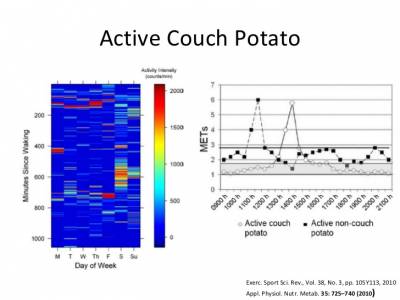
“Too much sitting is not the same as too little exercise. It is still possible to meet the current exercise guidelines to be active and still sit for too long”.
An “active couch potato” is a person who sits for up to 9-10 hours of their waking day and yet still goes to the gym and performs moderate to vigorous exercise for at least one hour per day.
This is very controversial, as studies using very sensitive equipment have now supported the idea of sedentary behavior in active people.

In a study reported by Genevieve Healy, subjects accumulated over 30 minutes of moderate to vigorous activity in the gym, while still spending 71% of their waking time in sedentary activities such as sitting.
This indicates that people can be very active yet be highly sedentary and still suffer from its consequences!!
Some landmark information now reveals that those fit people who exercise for over 150 minutes of vigorous exercise still spend over 60% of their free time in sedentary activities.
Based on the new information available you could be regarded as physically active and fulfilling the national general exercise recommendations while spending as little as 3% of your waking time performing moderate to vigorous exercise in an exercise environment.
The remaining time has been reported in sedentary activity (58%) and light intensity activity (39%).
The most important point to realise is that if you are vigilant in going to the gym for an hour per day that this still will not stop or solve the problems of a sedentary lifestyle!! It is not just about doing intense fitness activities for one hour per day, it is about changing your lifestyle to move throughout the day as much as possible at a low to moderate intensity.
If you performed 60-70% of your waking hours in low to moderate intensity activity areas such as domestic, occupational, transportation etc and 20-30% in sedentary activity without any vigorous exercise activity you can still be regarded as active producing significant reductions in risk factors.
You have now become an “active non-exerciser”. While this profile is quite common its impact and benefits have received little attention.
In combination with the current formal exercise recommendations people who accumulate movement during their day within small time frames of multiple muscle contractions make significant impacts on energy expenditures.
Non Exercise Activity Thermogensis (NEAT) is used to describe the energy expenditure that accompanies physical activities other than voluntary movements in an exercise program and includes activities of daily living, fidgeting, spontaneous muscle contractions, maintaining posture, standing etc.
NEAT could be any low-moderate intensity movements that are not structured into a formal exercise program.
To demonstrate the importance of NEAT, if you “walked and worked” for half of the working day and weighed 70Kg you would expand an additional 100 kcal per hour, which could over a working day translate into 400 Kcals per day, a weekly Kilocalorie deficit of 2,000 Kcals, a monthly deficit of 8,000 Kcals and weight loss over 12 months of over 13 kilograms!!
Without any other activity-based intervention it is possible to lose in excess of 12 kilograms of body weight per year with very little change in normal behavior. If additional movement was employed during leisure time, home time and traveling to and from work greater significant changes to body weight could be made without additional financial cost and time.
The Australian Longitudinal Study on Women’s Health, which has been gathering information since 1996 reveal that:
-
Younger women who sat for more than 8 hours a day weighed 3.40 kgs more than those who sat less than 3 hours a day. Each additional hour of sitting was associated with 227grams weight gain.
- Middle age women who sat for more than 8 hours per day weighed 5.92 kgs more than those who sat for less than 3 hours a day. Each additional hour of sitting was associated with 747 grams weight gain.
- Older women who sat for over 8 hours a day weighed 5.64 kgs more than those who sat for less than 3 hours a day
What can we do!!
Our societies interaction with its current environment promotes labor saving sedentary behavior and the convenience of eating in combination are powerful forces.
The first step in gaining improved health is to create opportunities to move in your already existing environment to the point where output can at least match energy intake.
Opportunities have to be created in your home, with transport variations, in your workplace and during your leisure time for additional movement to be performed at a comfortable variable intensity in multiple bouts that can be maintained at a moderate level of intensity.
- We need to treat “moving as an opportunity rather than an inconvenience”.
- We have to become more active at a low to moderate intensity for at least 9 hours of a 16 hours waking day.
- We need to create an environment for constant postural change from sitting to standing to walking to sitting.Breaks in sitting time can have beneficial effects on your metabolic health.
In another study by Healey (2008) those subjects who interrupted their sitting time by transitioning to standing or walking short distances were regarded as “breakers” demonstrated a reversal of many of the side effects of sedentary behavior.
The other subjects who remained in a sitting position were regarded a “prolongers” continued to show detrimental effects of sedentary behavior.
Become a breaker, not a prolonger!
These results were independent of performing moderate to vigorous exercise.
Remember that standing and walking for one minute in 30 minutes can result in an additional 3 kcals of energy expended. Taken over a full 5 days week or 8 hours per day, if you stood and walked for one minute every hour you would effectively expend an additional120 kcals per week compared to your work colleagues who sit for the same period.
If you chose to stand and move at a self-selected pace for two minutes per hour per day per week it would result in 296 Kcal expended per week.
A significant 660 kcals would be expended if you stood and moved for 5 minutes per hour per day per week.
Based on this information if you stand and walk at work/home for 5 minutes per hour for 8 hours, 5 days per week for at least 50 weeks you could expend an additional 33,000 Kcals or 5 kilograms keeping all other aspects of life constant and so on………
In your weight loss journey would you choose to be an “Active Couch Potato” or an “Active Non Exerciser”?
All successful weight loss journeys need a physical activity component not just for the weight change but also for its significant health benefits.
Dr Paul Batman




